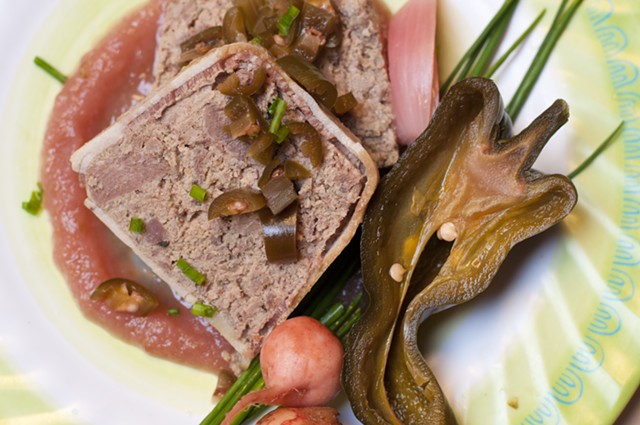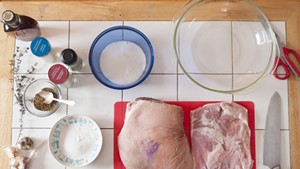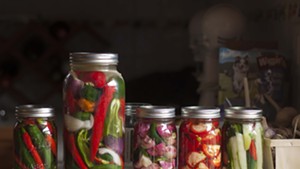
- Hannah Palmer Egan
- Pâté with pureed apple and pickle
Between soaking the liver, braising the tongue and shank and letting the assembled terrine rest a few days after baking, it took most of a week to make. It's a project dish, but it's not horribly labor intensive — it just takes time, and the rewards are quite lovely. After making this, you'll feel a keen sense of accomplishment.
This recipe isn't perfect, but it works very well. It's also fundamental enough to be flexible, so you can use whatever random organ meats you prefer. Because everyone has organ meats just kicking around, right? If not, use whatever is available at the store. Healthy Living Market & Café in South Burlington is my go-to shop for local organ meats, but your town butcher (or often farmers) should be able to provide liver or brains or bones or tongue with a little notice.
For this first run, I used about a pound of pork liver because that's what I had on hand. Next time, I'll use less, as the finished pâté was a little iron-rich for my taste. Also, I'll flambé the liver in brandy before processing it — I meant to do that this time but forgot. But serving the sliced terrine over homemade apple sauce offered similar ends (adding a touch of fruity sweetness) by different means.
You could substitute chicken or beef livers for the pork, or pig's tongues instead of beef — or heart meat for tongue, or pork butt for the lamb. The idea is to stud a liver/bone-stock matrix with hunks of long-braised organ and skeletal muscles. But the quantities and specific kinds are fairly negotiable. If you're worried your terrine won't cohere, add an extra egg.
The only non-negotiables are the liver — at least half a pound of it, from whatever beast you prefer — and bone stock. I always stress how much squirreling stock will help your cooking, and this is a case in point. Roasting a chicken for a weeknight dinner? Boil the bones with mirepoix (stock veggies) for several hours, strain into a quart container and freeze it ’til you need it.
Liver Pâté en Terrine
Makes two 14-inch terrines; serves 15-20
Ingredients:
- 1 large beef tongue (approx. 1 pound), trimmed
- 1 small lamb shank (approx. 1 pound, including bone)
- 1-2 quarts chicken or turkey stock
- 2 apples, halved
- 1 medium sweet onion, peeled and quartered
- 3 cloves garlic, crushed
- 1 bunch fresh tarragon, rinsed and trimmed of any dead leaves
- 1/2 teaspoon sea salt
- Fresh-cracked pepper, to taste
- 1/2 to 1 pound pork liver
- 2-3 cups milk
- Optional: 1/2 cup apple brandy or cognac, plus 1-2 tablespoons butter, for searing
- 1 1/2 cups stale bread, in chunks
- 2-3 cloves garlic
- Salt and pepper to taste
- 1/2 teaspoon each: cumin, powdered cayenne, pepper
- 1 apple
- 1 egg
- 1 1/2 to 3 cups stock
- 1 pound sliced bacon, or ample butter to grease terrine molds
- Place the tongue, shank, stock, halved apples and onion, garlic, tarragon, salt and pepper in a large saucepan and braise on low heat (or on a stone on your woodstove, or in a crockpot) 6-8 hours. As the stock cooks down, add water, one cup at a time, and turn the meat so that everything cooks evenly. When the lamb starts to pull away from the bone and the tongue yields to firm pressure, place the meat in a bowl to cool. Strain stock through a fine-mesh sieve and refrigerate. You should end up with about a quart of stock.
- When the meat is cool, pull the lamb from the bone and peel the beef tongue. (If you've never done this, it's pretty intuitive. On the outside of the tongue is a rubbery skin; slide a knife under it and peel it like you would a grape until you've removed all the skin. If you've braised the tongue for long enough, it should pull away with minimal effort.
- Rinse the liver, de-vein and cut into 1 1/2-inch chunks. Place in a bowl and pour milk over to cover and refrigerate for at least four hours, and up to two days. If desired, sear the liver briefly in a well-buttered cast-iron pan over high heat; flambé with 1/2 cup of apple brandy. When the flames die down, reserve any liquid.
- When the meat is braised, the liver soaked (and seared/flambéed), and the rest of the ingredients assembled, get out your food processor. Pulse the liver until it's in chunks no larger than your pinky nail. Rinse in a wire-mesh sieve if you're iron-averse.
- Preheat oven to 325 degrees F. and set a large pot of water on the stove to boil.
- Pour the liver into a bowl. Pulse the bread in the processor with the garlic, salt, pepper and spices. Add to bowl with liver. Core the apple and chop it to a fine dice in the food processor; add this to the liver mixture.
- Cut the peeled tongue into 1 1/2-inch pieces and process to a loose dice — half-inch chunks. Process the pulled lamb meat to a similar size and add both meats to the liver.
- Crack an egg into the meat mixture and blend well.
- Heat the stock just enough to melt it (if you started with a nice bone stock, it should be fairly gelatinous, especially after braising the lamb shank and beef tongue). Turn off heat and add stock to liver, one cup at a time, until the mixture is roughly the consistency of lumpy cake batter.
- If you've pre-seared your liver, add the reserved searing liquid; you'll likely need two or three cups of stock, rather than one and a half.
- Line two terrine molds with bacon (allow bacon ends to hang over the edge of the molds), or grease generously with butter. Pour the meat mixture into the pans. If using bacon, fold the bacon ends over the top of the meat. Cover with a lid, or with wax paper pressed into the top of the terrine.
- Place the two terrines in a large roasting pan that's at least three inches deep. When the water boils, pour into the roasting pan until it rises two inches along the sides of the terrine molds.
- Bake for one hour. Turn pan and bake another hour, or until the terrines reach an internal temp of 150* degrees F.
- Remove the pâtés from the oven. Press the meat into the mold with 3-5 pounds of weight each. If you do not own weights, place blocks of wood (or something else flat that will distribute weight evenly) on top of the terrines, and something heavy on top of the wood blocks. I used a pan full of water for one, and a bacon weight and butter dish for the other. Allow to cool several hours or overnight, then refrigerate for three or four days before serving.
- When you're ready to serve, a good way to cut the terrine is with a hot, wet, non-serrated knife. Cut the terrine one slice at a time, holding the knife at a steep angle to the bottom of the mold, starting at one side of the mold and pulling smoothly to the other edge. Remove each slice carefully as you would with meatloaf or pie, and re-heat/wet the knife between slices. Serve with crackers or crusty bread and unsweetened, cooked apples — in sauce or otherwise — and pickled vegetables.
Update, April 5, 2016: This post has been updated to reflect USDA food safety recommendations.
Speaking of...
-

A Multilayered Career Leads a Seasoned Chef to Middlebury’s Swift House Inn
Mar 12, 2024 -

Swedish Cinnamon Rolls: A Recipe for 'Kanelbullar'
Mar 12, 2024 -

Mealtime: Greek-Style Lamb Chops
Nov 14, 2023 -

Home on the Range: Reader Recipe Request for 'Lesbian Kale Salad'
Sep 19, 2023 -

Mealtime: Borani Kadoo and Bolani
Aug 22, 2023 - More »








Comments
Comments are closed.
From 2014-2020, Seven Days allowed readers to comment on all stories posted on our website. While we've appreciated the suggestions and insights, right now Seven Days is prioritizing our core mission — producing high-quality, responsible local journalism — over moderating online debates between readers.
To criticize, correct or praise our reporting, please send us a letter to the editor or send us a tip. We’ll check it out and report the results.
Online comments may return when we have better tech tools for managing them. Thanks for reading.